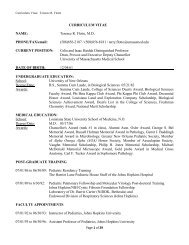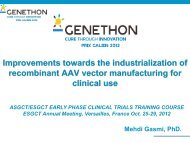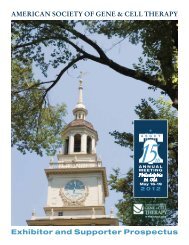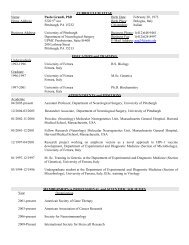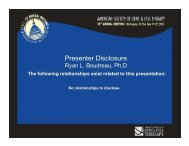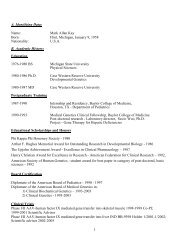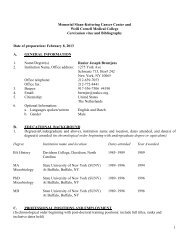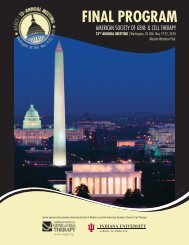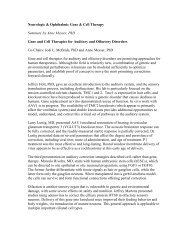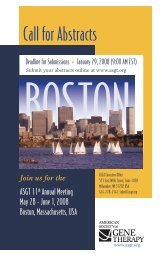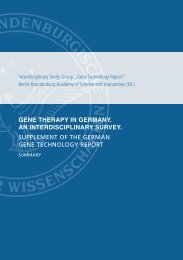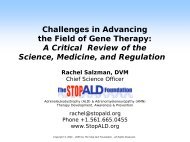Final Program - American Society of Gene & Cell Therapy
Final Program - American Society of Gene & Cell Therapy
Final Program - American Society of Gene & Cell Therapy
You also want an ePaper? Increase the reach of your titles
YUMPU automatically turns print PDFs into web optimized ePapers that Google loves.
<strong>Program</strong> Schedule, Friday, May 17, 2013<br />
Judy Lieberman, MD, PhD<br />
Aptamer-siRNA Chimeras Targeting CD4 <strong>Cell</strong>s Inhibit HIV Transmission<br />
One attractive strategy for interrupting HIV transmission is a topical microbicide, but the need for application around the time <strong>of</strong><br />
sexual intercourse leads to poor patient compliance. Intravaginal application <strong>of</strong> CD4 aptamer-siRNA chimeras (CD4-AsiCs) targeting<br />
the HIV coreceptor CCR5, gag and vif protected humanized mice from sexual transmission. In nondividing cells and tissue, RNAimediated<br />
gene knockdown lasts for several weeks, providing an opportunity for infrequent dosing not temporally linked to sexual<br />
intercourse, when compliance is challenging. In follow-up studies, we investigated the durability <strong>of</strong> gene knockdown and protection,<br />
protection afforded by CCR5 or HIV gene knockdown on their own, and effectiveness <strong>of</strong> CD4-AsiCs formulated in a gel in polarized<br />
human cervicovaginal explants and in humanized mice. These data, showing persistent gene knockdown and sustained protection<br />
that was improved in a gel formulation, suggest that CD4-AsiCs are a promising approach for developing an HIV microbicide.<br />
Scientific Symposium 314<br />
9:45 am - 11:45 am<br />
ROOM: 151 ABCG<br />
Realizing the Potential: Getting to Funding, Getting to Approval and Getting to Market<br />
CO-CHAIRS: Anthony T. Cheung, PhD and Karen Kozarsky, PhD<br />
SPEAKERS<br />
Sander van Deventer, MD, PhD<br />
Development <strong>of</strong> a Commercial <strong>Gene</strong> <strong>Therapy</strong> Product<br />
The market authorization <strong>of</strong> Glybera by the EMA has given development <strong>of</strong> gene therapies a signiicant boost. In this presentation<br />
I will discuss regulatory and inancial challenges associated with the development <strong>of</strong> (future) gene therapy products, which is<br />
essential for successful transition <strong>of</strong> academic projects into commercial products.<br />
David Kirn, MD<br />
Oncolytic and Immunotherapeutic Vaccinia Viruses for Cancer: Clinical Pro<strong>of</strong>-<strong>of</strong>-concept with JX-594<br />
(Pexa-Vec)<br />
This talk will be an overview <strong>of</strong> oncolytic and immunotherapeutic vaccinia viruses for cancer, with a focus on clinical pro<strong>of</strong>-<strong>of</strong>concept<br />
data with JX-594 (Pexa-Vec). Dr. Kirn will review this emerging novel therapeutic class, including the scientiic rationale<br />
for cancer-selectivity, mechanisms-<strong>of</strong>-action, and human clinical trial data from Phase 1 and 2 studies with Pexa-Vec. Clinical trial<br />
data will include pharmacokinetics, pharmacodynamics, tumor biopsy analyses, safety, anti-cancer eficacy and survival. Data from<br />
a randomized dose-inding Phase 2 trial will be presented, demonstrating a dose-related overall survival beneit <strong>of</strong> high dose Pexa-<br />
Vec treatment in patients with advanced liver cancer (Nature Medicine 2013).<br />
Samuel C. Wadsworth, PhD<br />
Realizing the Potential: Getting to Approval and Getting to Market; Focus on Orphan Indications<br />
The successful path to approval and market for new drugs is a series <strong>of</strong> effective decisions. Basic science, clinical research and<br />
manufacturing expertise represent some <strong>of</strong> the major stepping stones on this path, although there are many others. Academic<br />
scientists, regulators, corporate scientists, regulators, patients and patient advocacy groups all play their roles on the journey. For<br />
new technologies like cell and gene therapy, the beacon that should guide us throughout this journey should be the demonstration<br />
<strong>of</strong> truly transformative beneit to patients.<br />
Friday, May 17, 2013<br />
Artur Isaev, MD, MBA<br />
Development, Clinical Trials and Registration <strong>of</strong> Neovasculgen® <strong>Gene</strong> Therapeutic Drug<br />
Presentation will cover the key steps in “Neovasculgen” VEGF165 plasmid gene therapy drug development and commercialization<br />
starting from choosing a target disease to its marketing, including assessment <strong>of</strong> key characteristics <strong>of</strong> the future drug,<br />
determination <strong>of</strong> the therapeutic approach to be used and design and performance <strong>of</strong> preclinical studies. The main focus <strong>of</strong><br />
the talk would be on “Neovasculgen” clinical trials design for chronic lower limb ischemia and their main results, which would<br />
highlight the necessity <strong>of</strong> precise deinition <strong>of</strong> the end points to obtain objective data about safety and eficacy <strong>of</strong> the drug. <strong>Final</strong>ly,<br />
the presentation would summarize speciicity <strong>of</strong> drug development in Russia, current stage <strong>of</strong> “Neovasculgen” development, and<br />
perspectives <strong>of</strong> plasmid gene therapy in general.<br />
PANEL DISCUSSION<br />
MODERATOR<br />
Estuardo Aguilar-Cordova, PhD<br />
<strong>Final</strong> <strong>Program</strong> SALT LAKE CITY, UTAH May 15–18, 2013<br />
61



